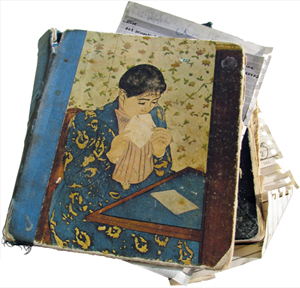Last-known address book
It’s more relic than resource, but why give up history?
By Mary Ruth Yoe
Photography by Joy Olivia Miller
The helpful people at support.apple.com offer a quick tutorial called Mac 101: Address Book. It’s another tutorial I skipped, preferring the hunt-and-click method of learning, especially when it’s something that seems to be done pretty much the same way by hand or by keyboard.

The Mac people don’t agree. With the unfettered enthusiasm of the self-help genre, the tutorial touts its product: “Whether you’ve got all your contacts stored neatly in some electronic device or are still hanging on to your tattered address book, personal organizer, or business card collection, Address Book makes managing the important people in your life simple.”
The tattered volume at right is my second—and perhaps last—address book. I’ve had it almost since losing the first one, included in a monogrammed leather writing case received as a high-school graduation present when going off to college meant writing letters home. Small and slim, the address book slipped easily into one’s purse or pocket for a trip to the post office. And, just as easily, it slipped out of my pocket.
The loss was poetic justice. Before e-mail and Skype, phone calls from Scotland, where I was in graduate school, to the United States cost about $1.50 per minute, making them a luxury. That winter a rumor spread through the American students in Edinburgh: find a bright-red British phone box old enough to have witnessed World War II, slip a few pence into the slot, and call home. Chances were good that, thanks to some quirk in the system, you could talk for 20 minutes or more. In time, the long queues of expats at vintage phone boxes gave the game away, but not before my address book was lost during a successful call.
By the time I received its replacement—a gift from one of the friends I’d called—I’d learned the first lesson of address books: they’re essentially irreplaceable. In its short life, the book had collected names, addresses, and numbers of persons who no longer played starring roles in my day-to-day drama yet were actors I liked to remember. Even if their addresses could be tracked down again, it seemed unsporting to re-enter their names in my lists: as with Facebook, it takes two people to be friends.
So I embraced the new. With italic-nib and India ink, I carefully penned addresses for the ages. Within months, the entries were crossed out and crossed out again. Handwriting got sloppier, ink colors changed. Eventually I began tearing off address labels and taping them into place. Sometimes friends were pressed into service, scrawling their info on the appropriate page for later decoding. Without moving, some people acquire new names, partners, or addresses (a cousin has lived in the same house for 25 years, yet her town has changed from Baltimore to Woodlawn to Gwynn Oak).
Giving up on order, I embraced the chaos, seeing in each crossed-out and re-entered listing the underlying thread of a shared personal history. But sometimes those threads snap. If I throw away my tattered address book, the person who gave it to me can no longer be entered. Managing the important people in your life is not simple, or even possible, no matter what format you use.
Speaking of addresses
In whatever format you keep your own address book, we hope you’ll let the Magazine know whenever your address or e-address changes (write us at uchicago-magazine@uchicago.edu). We’ll happily forward the change to the keepers of the alumni database. After all, you’re important people in our lives.
